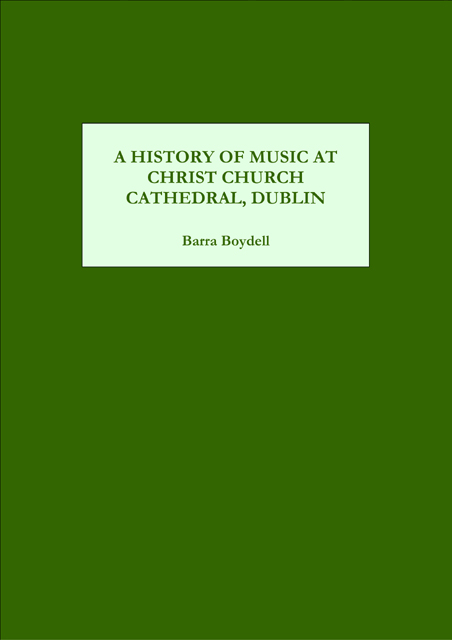Book contents
- Frontmatter
- Contents
- Plates and Musical Examples
- Foreword
- Preface
- Editorial Conventions
- Introduction
- One ‘Dulces Fecit Modos’: The Medieval Cathedral-Priory
- Two ‘For the More Honour of God’s Divine Service’: The Reformation and Early Seventeenth Century
- Three “So Great and Solemn Service’: The Restoration and Later Seventeenth Century
- Four ‘The Increasing Excellence of the Choir’: The Eighteenth and Early Nineteenth Centuries
- Five ‘A More Efficient Performance of the Duties of the Choir’: The Mid-Nineteenth Century
- Six Decline and Revival: Disestablishment and the Twentieth Century
- Appendix One Succession Lists of Organists and Assistant Organists
- Appendix Two Succession List of Masters of the Boys/Music Masters/Choir Masters
- Abbreviations and Bibliography
- Index
Three - “So Great and Solemn Service’: The Restoration and Later Seventeenth Century
Published online by Cambridge University Press: 21 March 2023
- Frontmatter
- Contents
- Plates and Musical Examples
- Foreword
- Preface
- Editorial Conventions
- Introduction
- One ‘Dulces Fecit Modos’: The Medieval Cathedral-Priory
- Two ‘For the More Honour of God’s Divine Service’: The Reformation and Early Seventeenth Century
- Three “So Great and Solemn Service’: The Restoration and Later Seventeenth Century
- Four ‘The Increasing Excellence of the Choir’: The Eighteenth and Early Nineteenth Centuries
- Five ‘A More Efficient Performance of the Duties of the Choir’: The Mid-Nineteenth Century
- Six Decline and Revival: Disestablishment and the Twentieth Century
- Appendix One Succession Lists of Organists and Assistant Organists
- Appendix Two Succession List of Masters of the Boys/Music Masters/Choir Masters
- Abbreviations and Bibliography
- Index
Summary
The Restoration in 1660 initiated a period of exceptional activity and creativity in the musical life of Christ Church cathedral. This activity is closely related to the cathedral’s role as the state cathedral and chapel royal for the English administration in an Ireland whose political and religious landscape had been transformed since the 1640s. More than a decade of warfare had followed the rebellion in October 1641 in which the lines of conflict were not simply defined. Initially the Irish Catholics had risen in rebellion in Ulster where the largest numbers of Protestant plantations and land seizures had taken place. They were soon joined by many of the ‘Old English’ throughout Ireland, the Catholic gentry and landowners who traced their ancestry back to English settlers of the medieval period and who most often supported the English Royalist cause. Matters were complicated by the outbreak of the Civil War in England, the insurrection against English rule and appropriation of land becoming clouded by many of the Irish Catholic gentry’s support for the English Royalist cause, the rebellion increasingly taking the form as much of a religious war as of a war of independence. Oliver Cromwell’s arrival in Ireland in 1649 marked the beginning of nine months of ruthless repression and reconquest which have ever since made Cromwell into ‘a by-word for brutality, and the worst personification of that English racial and religious animus against the Irish which stretched over several centuries’. By the late 1650s the exclusion of Ireland’s majority Catholic population from land ownership, public office and political rights had begun, a process which would culminate in the discriminatory penal laws enacted from the 1690s. The Restoration in 1660 thus marked not just the return to power of the monarchy and the re-establishment of cathedral services after the Commonwealth: it also saw the consolidation of English rule in Ireland after nearly two decades of unrest and political uncertainly and defined the demarcation of political difference along religious lines which has haunted Anglo-Irish relationships ever since.
The Restoration also ushered in a new era in cathedral music following the complete break in the practice of cathedral music since the 1640s.
- Type
- Chapter
- Information
- A History of Music at Christ Church Cathedral, Dublin , pp. 63 - 100Publisher: Boydell & BrewerPrint publication year: 2004



